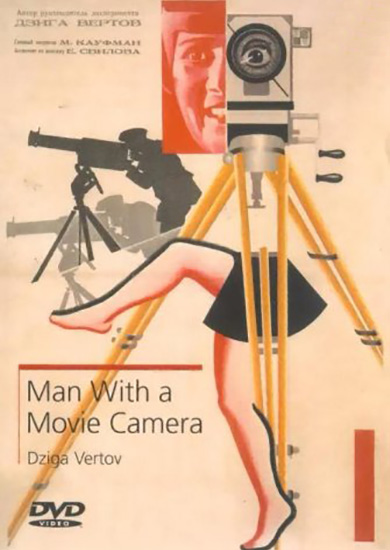Man with a Movie Camera
An extraordinary Russian documentary from 1929 that explores the art of film and film makers. It shows a man traveling around a city with a camera slung over his shoulder, documenting urban life and the result is a film with dazzling invention.
Film Notes
This magnificent movie… defies attempts at explanation, and in fact, it has a unique way of wriggling out of any category you might try to impose on it. It appears to be a City Symphony but it is a fraudulent one – filmed in three cities and naming none of them. If I could rechristen this film, as its director did himself, when he went from plain David Kaufman to the far more evocative Dziga Vertov, I would call it Woman with a Moviola. The new name would be in honour of Yelizaveta Svilova, who edited the film with Vertov, and whom we see stitching together frames midway through the film. The man of the title clambers, and tilts and gets where the action is, that’s for sure, as any camera operator should do. But the magic of this film is in its elaborate construction, its celebration of those arts that are purely cinematic – not offcuts from other media. As Roger Ebert said when he reviewed the film in 2009: “It’s what you do after you have your frames that makes it cinema.” Svilova is also arguably the least well-known of the “council of three” comprising herself, her husband Vertov and his brother-cinematographer Mikhail Kaufman. The soundtrack on offer here is by Michael Nyman. Purposefully, Nyman did not consult Vertov’s notes on his musical requirements, and yet, his score feels more reverent, less cheeky. There is another digital restoration of the film, with a soundtrack by Alloy Orchestra, incorporating cues from Vertov himself. It’s a brilliant package – the most physically intense, almost overpowering, experience I have had watching this movie.
Pamela Hutchinson - Editor of Silent London - 2013
Around the clock in a Soviet city is depicted by camera flashes in a film known as "Living Russia or the Man With the Camera," It is much like "Berlin, a Symphony of a Big City," only it hardly matches its German rival in interest, principally because its glimpses are too fleeting. It is a disjointed array of scenes in which the producer, Dziga Vertoff, does not take into consideration the fact that the human eye fixes for a certain space of time that which holds the attention. In the German film there was a suggestion of poetry, but in the Russian offering there is only originality to redeem it. As a matter of fact it becomes quite tedious and the hour that it lasts seems least an hour and a half. There are undoubtedly clever stretches in this picture, which was photographed in Odessa, Kharkov and Kieff. The notion of having everything come to a sudden stop is ingenious, especially when one discovers that the reason is that a motion picture film joiner is pausing at her work. The slow-motion passages of athletes diving, throwing the shot and other physical exercises are well conceived. The wheels of business and industry being set in motion is another laudable phase of this feature. But often one would like to dwell upon some of the doings.
Mordaunt Hall - New York Times - Sept 17th 1929
In 1929, the year it was released, films had an average shot length (ASL) of 11.2 seconds. "Man with a Movie Camera" had an ASL of 2.3 seconds. The ASL of Michael Bay's "Armageddon" was -- also 2.3 seconds. Why would I begin a discussion of a silent classic by discussing such a mundane matter? It helps to understand the impact the film made at the time. Viewers had never seen anything like it, and Mordaunt Hall, the horrified author of the New York Times review, wrote: "The producer, Dziga Vertof, does not take into consideration the fact that the human eye fixes for a certain space of time that which holds the attention." This reminds me of Harry Carey's advice in 1929 to John Wayne, as the talkies were coming in: "Stop halfway through every sentence. The audience can't listen that fast." "Man with a Movie Camera" is fascinating for many better reasons than its ASL, but let's begin with the point Dziga Vertof was trying to make. He felt film was locked into the tradition of stage plays, and it was time to discover a new style that was specifically cinematic. Movies could move with the speed of our minds when we are free-associating, or with the speed of a passionate musical composition. They did not need any dialogue -- and indeed, at the opening of the film he pointed out that it had no scenario, no intertitles, and no characters. It was a series of images, and his notes specified a fast-moving musical score. There was an overall plan. He would show 24 hours in a single day of a Russian city. It took him four years to film this day, and he worked in three cities: Moscow, Kiev and Odessa. His wife Yelizaveta Svilova supervised the editing from about 1,775 separate shots -- all the more impressive because most of the shots consisted of separate set-ups. The cinematography was by his brother, Mikhail Kaufman, who refused to ever work with him again. (Vertov was born Denis Kaufman, and worked under a name meaning "spinning top." Another brother, Boris Kaufman, immigrated to Hollywood and won an Oscar for filming "On the Waterfront.") Born in 1896 and coming of age during the Russian Revolution, Vertov considered himself a radical artist in a decade where modernism and surrealism were gaining stature in all the arts. He began by editing official newsreels, which he assembled into montages that must have appeared rather surprising to some audiences, and then started making his own films. He would invent an entirely new style. Perhaps he did. "It stands as a stinging indictment of almost every film made between its release in 1929 and the appearance of Godard’s 'Breathless' 30 years later," the critic Neil Young wrote, "and Vertov’s dazzling picture seems, today, arguably the fresher of the two." Godard is said to have introduced the "jump cut," but Vertov's film is entirely jump cuts. There is a temptation to review simply by listing what you will see in it. Machinery, crowds, boats, buildings, production line workers, streets, beaches, crowds, hundreds of individual faces, planes, trains, automobiles, and so on. But these shots have an organizing pattern. "Man with a Movie Camera" opens with an empty cinema, its seats standing at attention. The seats swivel down (by themselves), and an audience hurries in and fills them. They begin to look at a film. This film. And this film is about -- this film being made. The only continuing figure -- not a "character" -- is the Man with the Movie Camera. He uses an early hand-cracked model, smaller than the one Buster Keaton uses in "The Cameraman" (1928), although even that one is light enough to be balanced on the shoulder with its tripod. This Man is seen photographing many of the shots in the movie. Then there are shots of how he does it -- securing the tripod and himself to the top of an automobile or the bed of a speeding truck, stooping to walk through a coal mine, hanging in a basket over a waterfall. We see a hole being dug between two train tracks, and later a train racing straight towards the camera. We're reminded that when the earliest movie audiences saw such a shot, they were allegedly terrified, and ducked down in their seats. Intercut with this are shots of this film being edited. The machinery. The editor. The physical film itself. Sometimes the action halts with a freeze frame, and we see that the editor has stopped work. But that's later--placing it right after the freeze frame would seem too much like continuity. If there is no continuity, there is a gathering rhythmic speed that reaches a crescendo nearer the end. The film has shot itself, edited itself, and now is conducting itself at an accelerating tempo. Most movies strive for what John Ford called "invisible editing" -- edits that are at the service at the storytelling, and do not call attention to themselves. Even with a shock cut in a horror film, we are focused on the subject of the shot, not the shot itself. Considered as a visual object, "Man with a Movie Camera" deconstructs this process. It assembles itself in plain view. It is about itself, and folds into and out of itself like origami. It was in 1912 that Marcel Duchamp shocked the art world with his painting "Nude Descending a Staircase." It wasn't shocked by nudity -- the painting was too abstract to show any. They were shocked that he depicted the descent in a series of steps taking place all at the same time. In a way, he had invented the freeze frame. What Vertov did was elevate this avant-garde freedom to a level encompassing his entire film. That is why the film seems fresh today; 80 years later, it is fresh. There had been "city documentaries" earlier, showing a day in the life of a metropolis; one of the most famous was "Berlin: Symphony of a Great City" (1927). By filming in three cities and not naming any of them, Vertov had a wider focus: His film was about The City, and The Cinema, and The Man with a Movie Camera. It was about the act of seeing, being seen, preparing to see, processing what had been seen, and finally seeing it. It made explicit and poetic the astonishing gift the cinema made possible, of arranging what we see, ordering it, imposing a rhythm and language on it, and transcending it. Godard once said "The cinema is life at 24 frames per second." Wrong. That's what life is. The Cinema only starts with the 24 frames -- and besides, in the silent era it was closer to 18 fps. It's what you do after you have your frames that makes it Cinema. The experience of "Man with a Movie Camera" is unthinkable without the participation of music. Virtually every silent film was seen with music, if only from a single piano, accordion, or violin. The Mighty Wurlitzer, with its sound effects and different musical voices, was invented for movies. The version available in the U.S. is from Kino, and features a score by composer Michael ("The Piano"). It was premiered performed by the Michael Nyman Band on May 17, 2002 at London's Royal Festival Hall. As the tempo mounts, it takes on a relentless momentum. Another score was created by the Cinematic Orchestra, and you can hear it while viewing nine minutes of the film here: http://www.youtube.com/watch?v=vvTF6B5XKxQ A famous score was created by the Alloy Orchestra of Cambridge, Mass., which devotes itself to accompanying silent cinema. To mark the 80th anniversary of the film, the Alloy obtained and restored a print from the Moscow Film Archive.
Roger Ebert - Chicago Sun Times - July 1st 2009
What you thought about Man with a Movie Camera
Film Responses
| Excellent | Good | Average | Poor | Very Poor |
|---|---|---|---|---|
| 10 (13%) | 35 (47%) | 15 (20%) | 11 (15%) | 4 (5%) |
|
Total Number of Responses: 75 Film Score (0-5): 3.48 |
||||
Collated Response Comments
110 of you came along to the screening of the “Man with a Movie Camera”. 108 stayed to the end of the programme. 68% of you completed the comment slip. Thank you. The summary of the results of your observations shown above indicate that 40 % rated the film average and below. That is not to say that those 60% who scored it in the other categories poured universal praise; they certainly did not. However on many of the comments forms there WAS universal praise for the NFTS short film “How I Didn't Become a Piano Player”. “Brilliant short”. “The short was fun and well done”. “Short excellent”. “The short was brilliant-the best that GFs has ever shown”. “More of these if they are amusing and not introspective”. “Short excellent- loved it”. “The first film hit the right notes!” “The short could have been longer and the long film could have been shorter” are a few of the observations that I have picked out. Now we come to your points of view about our Russian film which some said was an “extraordinary and an excellent portrayal of 1929 soviet Russia” with “a fascinating if uncritical celebration of Russian city life as it embraced modernity” and “a remarkable tour de force…. real originality and substance in the images of a society in transition” .”Very clever juxtapositions. People looked happy and life healthy in Odessa in 1929”. A “staggering piece of filmmaking for 1929. Amazing cinematography and editing. Very interesting snapshot of soviet life only 12 years after the revolution”. So the film for some worked on one level with the apparent depiction of some parts of Russian life in 1929; we should remember that the film took four years to make and was released in 1929. However, while for many the film was a “fascinating record, the music distracted from its originality”, and “the overall impact was spoiled by much repetition and frightful soundtrack” others agree; saying that “the main film was challenging and quite extraordinary for its time” ….with “mesmerising images that held the attention throughout, inducing a trance like reaction, or would have done if not for the brutally intrusive, totally unnecessary Nyman soundtrack”. One commentator observed that the film “flicked about in a migraine inducing way”, and “could have been interesting with less technical wizardry and more attention to topics” another commented; “an hour of fascinating historic film spoilt by irrelevant, noisy aggressive soundtrack”. To one member the film represents “... the reason why I joined this film society. To be challenged, stimulated, educated and entertained. A thoroughly great evening. Keep it up”. While others told us that it was “possibly the least satisfying evening I had in 10 years”, “a wasted evening”, “one big headache”, “tedious music. Boring”. “Ahead if its time no doubt, but for my modern taste one of the most exhausting and sadly, boring hours so far at the film society”. “An interesting technical and creative feat for 1929, but hard to see the artistic point or theme in much of it”. One felt that they would “need reading notes and a test afterwards” with another saying “an hour I will never get back. Sorry not my type of film”.



